Before we decide to implement a stricter operational practices, we needed to find out how many routes with invalid origins are actually being used and how much traffic is exchanged using those routes. Please find the results below.
Current setup
SURFnet has been working on RPKI for a while. One of the results of this is the RPKI dashboard [1]. This dashboard gives an overview of the use of RPKI looking at routes and their validation state.
Since some time we have implemented the RPKI validation software and are using this data in our production routers. All routes we learn from our external BGP sessions are labeled with the validation state. Customer prefixes aren’t labeled.
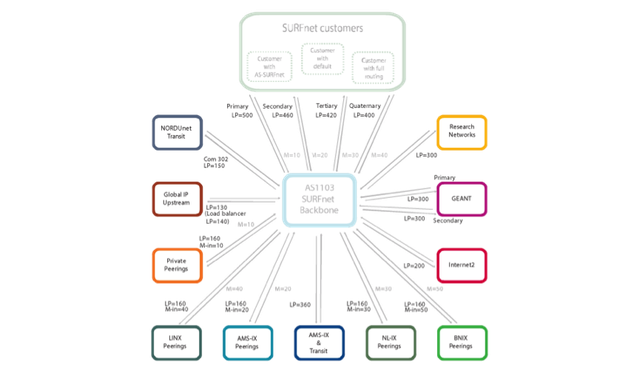
Figure 1 above shows SURFnets current routing policy (you can enlarge all image by clicking on them). We always prefer routes learned from customers above all external connectivity. For external connectivity we prefer routes learned from research networks above private peerings followed by IX peerings and as a last resort we have two global upstream connections.
All these connections result in a BGP table with currently approximately 478,000 active IPv4 routes. From these routes approximately 2,560 routes are marked invalid, 18,800 are valid and 456,000 are unknown or not found.
Policy decision making
For RPKI to make any sense, the RPKI origin validation operational draft [2] suggests to drop (or at least lower the preference for) all invalid routes, and to prefer routes marked valid above the unknown routes.
Currently SURFnet is not adhering to this recommendation. Before doing this we needed to have more detailed information and have confidence that we won’t introduce major problems by filtering on RPKI validation states. By using the RPKI system we now know the routes and origin Autonomous System Numbers (ASNs) from which we receive routes with invalid origins. But what is going on there? How much traffic is it and what kind of traffic?
Using a measurement tool from Deepfield [3] and using BGP communities we are able to measure traffic for each of the different validation states (valid, invalid and unknown origins).

As most routes in the routing table are of unknown origin and the smallest number of prefixes are of invalid origin, total traffic levels are distributed as expected.
But can we drop this small amount of traffic? Would customers start complaining if we would apply the routing policy to drop invalid origins and adhere to the operational practices as described in the IETF draft? For that we needed to know more details about the invalid origin traffic.
Using the capabilities of the Deepfield system we were able to classify traffic from invalid origins into groups.
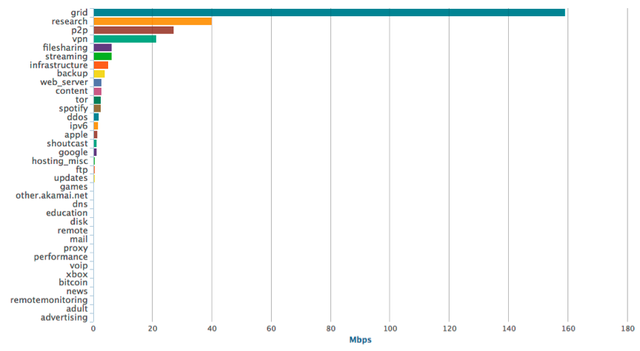
The picture above clearly shows that most traffic is classified as ‘grid’ and ‘research’ traffic. If we dive deeper into the 'grid' traffic we see multiple origins as shown in Figure 4 below.
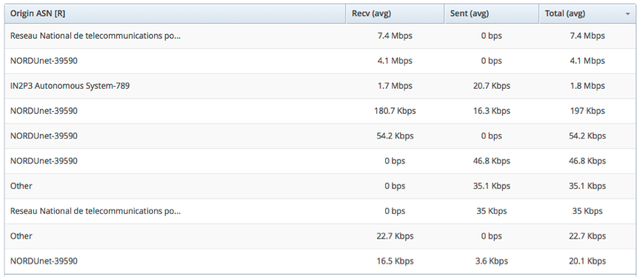
The top players here are Renater with AS2200 and NORDUnet with AS39590.
So can we drop these invalids? Using the RPKI dashboard it is visible what the problem is:
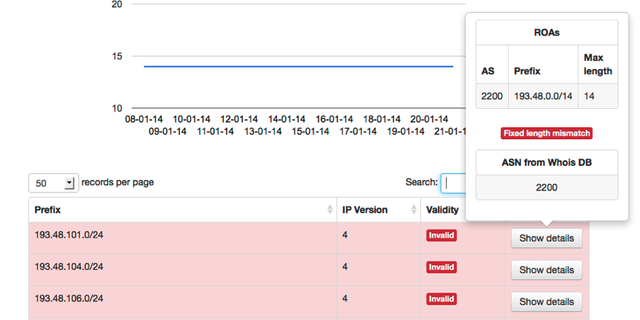
There is a prefix-length mismatch for a lot of /24s. According to the route origin authorisation (ROA), there is a covering route [4], but does this covering route also exist in the routing table? For this particular example it does:
> show route protocol bgp 193.48.0.0
193.48.0.0/14 *[BGP/170] 5w4d 17:46:51, localpref 100
AS path: 1103 20965 2200 I, validation-state: valid
This route has the same Origin AS, has a valid origin and is even following the same AS path as the more specific but invalid /24. Dropping these routes with invalid origin would cause no problems whatsoever.
Does this also count for the other 2,500 routes with invalid origins? Do all these routes have covering routes from the same origin AS?
After investigating this we found 2,564 routes with an invalid origin and from these routes we found 1,856 (72%) covering routes with a valid origin.
The interesting thing is that from these 1,856 covering routes 1,248 (67%) have an origin AS similar to the invalid route they cover and 608 (33%) covering routes have a different origin AS.
| # | AS | Invalid | Covering |
| 1 | 6147 | 608 | 552 |
| 2 | 237 | 174 | 184 |
| 3 | 23752 | 122 | 123 |
| 4 | 15557 | 38 | 85 |
| 5 | 7303 | 1 | 74 |
| 6 | 2200 | 1 | 56 |
| 7 | 39501 | 53 | 53 |
| 8 | 23383 | 50 | 50 |
| 9 | 9873 | 48 | 48 |
| 10 | 286 | 41 | 35 |
Table 1: Top 10 origin ASes with covering routes
Some of these origin ASes have more covering routes than invalid routes. This means they are not only announcing covering routes for their own routes with invalid origin but also announce routes that are covering routes with invalid origin from other ASes.
For example AS237 is covering 184 routes with invalid origin, while AS237 only announces 174 routes with an invalid origin. Ten of the announced routes by AS237 are thus covering routes announced by other ASes.
AS237 is covering routes from AS40044 and AS25773.
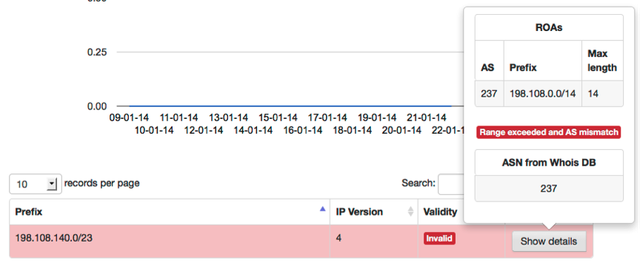
If we’d drop the routes with invalid origin announced by AS40044 and AS25773, AS273 would attract their traffic and we probably won’t reach the destination we were trying to reach.
So if we look at the total traffic using routes with invalid origin, we'll get the following results:
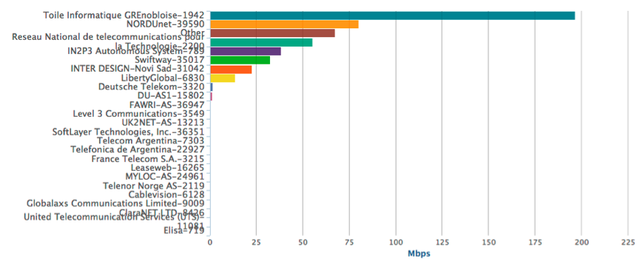
The biggest amount of traffic is exchanged with AS1942. From AS1942 we only receive one route with invalid origin, but is covered by a route from AS2200.
When we dive deeper into this route:
193.48.83.0/24 *[BGP/170] 2w0d 00:56:08, localpref 100
AS path: 1103 20965 2200 1942 I, validation-state: invalid
We see that AS2200 is the transit AS for AS1942. Using the looking glass of AS2200 we see that we probably would be able to reach the destination with the covering route with valid origin:
193.48.0.0/14 *[BGP/170] 11w1d 07:25:52, localpref 100
AS path: 1103 20965 2200 I, validation-state: valid
For the second biggest AS with whom we exchange traffic the game is different, we receive only one route from them:
109.105.124.0/22 *[BGP/170] 10w6d 21:50:35, localpref 100
AS path: 1103 2603 39590 I, validation-state: invalid
And this route isn’t covered by a route with a valid origin. So dropping this invalid route would cause the prefix(-es) to become unreachable. This is clearly caused by missing ROAs for the AS39590 routes.
We could continue doing this for all the ASes mentioned. The top 10 would then look as follows:
| # | AS | Invalid | Covered | Covered By |
| 1 | 1942 | 1 | 1 | 2200 |
| 2 | 39590 | 1 | 0 | 0 |
| 3 | 2200 | 1 | 1 | 2200 |
| 4 | 789 | 2 | 2 | 2200 |
| 5 | 35017 | 24 | 24 | 35017 |
| 6 | 31042 | 8 | 8 | 31042 |
| 7 | 6830 | 3 | 3 | 6830 |
| 8 | 3320 | 6 | 6 | 3320 |
| 9 | 15802 | 6 | 6 | 15802 |
| 10 | 36947 | 1 | 1 | 36947 |
Table 2: Top 10 total traffic ASes and their covering routes
All prefixes from these ASes are covered, except the one from AS39590. There will be no traffic exchange possible anymore if we drop routes with invalid origin from AS39590.
A route with origin AS2200 covers the routes from AS789. Again if we would drop the routes with invalid origin from AS789 the traffic exchange could still continue using AS2200
Routes with invalid origin:
193.48.99.0/24 *[BGP/170] 6w1d 05:33:16, localpref 100
AS path: 1103 20965 2200 789 I, validation-state: invalid
193.48.100.0/24 *[BGP/170] 6w1d 05:33:16, localpref 100
AS path: 1103 20965 2200 789 I, validation-state: invalid
And their covering routes:
193.48.0.0/14 *[BGP/170] 11w1d 08:17:07, localpref 100
AS path: 1103 20965 2200 I, validation-state: valid
Conclusion
Can we use RPKI and adhere to the operational practices by dropping routes with invalid origins? We tried to answer this question by investigating how many routes with invalid origins are actually being used and how much traffic is exchanged using those routes.
Using traffic measurements we tried to determine on which routes with invalid origin we had to focus. And we had to determine whether traffic could still be exchanged using alternative routes with a valid origin.
Looking at the results from this research we are able to say that we could adhere to a strict routing policy by dropping routes with an invalid origin and not lose to many routes. Of course this is a result from research on SURFnet data from last week. Whether you can adhere to this strict policy also depends on your traffic patterns.
We will continue to monitor the validation state for routes and the traffic pattern for some more time to see if the conclusions from this research are still valid over time. If we have enough evidence we can safely drop routes with invalid origins we will start doing that before the end of this year.
[1] The SURFnet RPKI Dashboard
[2] The RPKI origin validation operational draft
[4] Covering route: A less specific route exists for a certain more specific route


Comments 0
The comments section is closed for articles published more than a year ago. If you'd like to inform us of any issues, please contact us.